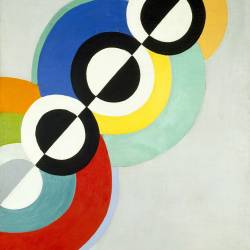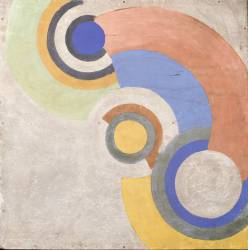Artwork of Robert Delaunay artprints & posters
A major artist in twentieth-century French painting, and an avant-garde painter who created the artistic movement of Orphism and contributed to abstract painting, Robert Delaunay's research into light and colour enabled him to establish himself on a par with other illustrious artists such as Georges Braque, Paul Klee and Pablo Picasso. Alongside his friends Kandinsky, Jean Metzinger, Michel Larionov and Fernand Léger, Delaunay was able to develop his art towards a representation of the outside world, in which the subject is represented by colour, outside any classical figurative form.
Discover Robert Delaunay's modern and contemporary art, with a reproduction on paper of his lithograph "La Tour Eiffel", a cubist painting whose theme was taken up many times by the artist, "Rythme, Joie de vivre", an oil painting in the collection available at the Centre Pompidou, and "Les Fenêtres Simultanées", an oil on canvas from his famous orphic series "Les fenêtres".
Treat yourself to one of the reproductions available in the catalogue of one of the great painters of French and European art history, and find out more about his life with his biography.
Biography of Robert Delaunay
The beginnings of Robert Delaunay: Childhood and training
Born in Paris in 1885 into a middle-class family, Robert Delaunay was soon at odds with the bourgeois precepts his parents wanted to impose on him. At a very young age, it was at the tenth Universal Exhibition, which was also the first exhibition the future painter attended, that he discovered and became fascinated by the Eiffel Tower, the new symbol of the city of Paris. Robert Delaunay was deeply influenced by this exhibition and the one in 1900, and drew inspiration from it throughout his life. His works reflect the modernity of the scientific discoveries on display, as well as the Eiffel Tower, which he reproduced on several occasions.
More interested in drawing than in school, Robert Delaunay began sketching outdoors during his holidays in the town of Saint-Éloy-de-Gy, and took up pastels during his studies. In 1902, having bypassed the École des Beaux Arts like many artists of his time, he began an apprenticeship as a scenic designer for Eugène Ronsin, a well-known painter and theatre decorator in Paris. It was during these years that he was introduced to lighting and perspective, essential elements in the theatre.
At the same time, Delaunay painted with his uncle Charles Damour, who gave him lessons in traditional painting. Attracted by the post-Impressionist movement, the young painter was already trying to assert his innovative vision, which was little accepted by his teacher at the time, leading to regular conflicts.
Robert Delaunay's evolution towards colour.
From 1904, when he was barely 20, Robert Delaunay began to find his artistic style. In his landscapes and still lifes, we find the artistic influence of the neo-impressionist and fauvist movements, in which colours take a predominant place on the canvas. Away from the Beaux Arts academy, Delaunay was more likely to make friends with young artists such as Jean Metzinger and Henri Le Fauconnier, whom he met on his return to Paris after taking part in the Salon des Indépendants, and with whom he exchanged views on the choice of colour in his work. In the oil on canvas "Portrait of Jean Metzinger" (1906), Fauconnier's influence can already be felt in his way of painting, where colour takes precedence over drawing. Developing a whole theory as part of his research into colour in drawing, Delaunay began to make a name for himself among the other innovative artists of his time. It was through his acquaintances that he met Sonia Terk, with whom he quickly began a relationship in 1909. In 1910, while his partner Sonia was pregnant, they married, opening a new chapter in the painter's life, with his wife accompanying him throughout his career.
A plunge into Cubism: L'Ère Orphique by Robert Delaunay.
While discovering the work of Picasso and the cubist painting of Cézanne, Robert Delaunay chose to move towards analytical cubism, and created the artistic movement of Orphism, in which light and colour took precedence over the object itself. In 1912, it was with his "Windows" series that Robert Delaunay really put in place his theory of simultaneism, conceived with his wife Sonia Delaunay. It was also during this period that he came into contact with Vassily Kandinsky, Michel Larionov, Giacometti and Paul Klee, took an interest in the work of Matisse and befriended Guillaume Apollinaire. Unlike his friend Kandinsky, or the works of artists such as Piet Mondrian, who were moving towards expressionism and pure geometric abstraction, with a real inner search, as a pioneer of Orphism, Delaunay, although using mainly circular geometric forms, sought his inspiration from the outside. Even if the subject was distorted in favour of colour, it remained at the centre of the canvas. His painting was closer to the vision of the cubist painter Pablo Picasso or that of Georges Braque.
During this period, Robert Delaunay exhibited and travelled extensively. First of all in Paris, with all the Parisian avant-garde artists, then abroad, with important German or Russian artists, who invited him to exhibit in Moscow or Berlin, where his paper on colour was even translated by Paul Klee. Painting from Louveciennes, Robert Delaunay's collection was exported throughout Europe thanks to his many contacts abroad.
Robert Delaunay and the decorative arts.
With the outbreak of the First World War, Robert and Sonia Delaunay decided to leave France, where the French painter was considered a deserter, and set off for Spain and then Portugal. From the Iberian peninsula, the Delaunays continued to paint, their compositions taking their inspiration from the surrounding landscapes, but always in an abstract, orphic style. Having lost some of their friends during the war, such as Franz Marc, but above all Guillaume Apollinaire, who died of Spanish flu, Robert and Sonia Delaunay returned to France in 1922, to Paris. Unappreciated by the painters of the time because of their desertion, with the exception of the painter Fernand Léger, with whom they continued to socialise, the couple became close to a circle of friends, some of whom they portrayed, from the world of Surrealist poetry. It was with his wife, and also Fernand Léger, that Robert Delaunay turned to the decorative arts. More renowned than her husband, Sonia Delaunay worked regularly on film sets and clothing, and her work was particularly appreciated at the 1925 Exposition des Arts Décoratifs. For this exhibition, Robert Delaunay was commissioned to decorate an embassy hall. He would once again present the Eiffel Tower, which would cause a scandal with its gigantic size.
Robert Delaunay, towards abstract painting.
After a period concentrating on the decorative arts and on the production of a series of portraits of his friends, around 1930 Robert Delaunay turned a page in his life and returned to the Orphism pictorial movement, in a more advanced form of abstraction, no doubt inspired by the abstract paintings of Piet Mondrian. In his "Rhythm" series, the circular shapes and colours took on an abstract dimension, culminating in the "Endless Rhythm" series, presented in a large-scale reproduction at the 1937 International Exhibition. Whereas up until then, Delaunay's works had been inspired by pictorial research into reality, with the series on rhythm, he wanted to represent light, and to do this he had to completely disregard figurative form in order to represent it in an abstract way. Although he would never define himself as an abstract painter, the abstract geometric shapes and the arrangement of colours outside of all reality point directly to this artistic movement.
In 1940, with the outbreak of the Second World War and the Nazi advance towards Paris, the Delaunays took refuge in Montpellier. After a spell in the small town of Mougins, Robert Delaunay died of lung problems in Montpellier in 1941.
Legacies and influence: Robert Delaunay's artistic legacy
Sonia Delaunay outlived her husband and continued to promote his work for the rest of her life, until 1979. She organised several exhibitions, bringing her husband's paintings to the attention of the general public, including his series on the Eiffel Tower and his "windows" series. Like a veritable biography of the French painter, these retrospectives showed the evolution of his art throughout the first half of the 20th century. Having left his mark on the art of his time, Delaunay is now considered, alongside the works of Picasso and Matisse, as one of the major artists of Cubism, but also as one of the precursors of abstract art, along with Kandinsky and Mondrian.
A whole collection of Robert Delaunay's paintings can be found all over the world. In France, he can be seen at the Centre Georges Pompidou, where we can admire his abstract painting "Rythme, joie de vivre", from his "Rythme" series, and at the Musée National d'Art Moderne in Paris (located in the Centre Pompidou) with "Rythme sans fin", at the Musée des Beaux Arts in Rennes and Quimper, where some of his early works are on display, and at the Musée d'Art Moderne in Paris and Troyes, where several of his paintings can be seen. Abroad, some of his representations of the Eiffel Tower can be seen at the Museum of Modern Art in New York, which houses some of the world's greatest works of modern and contemporary art, as well as at the Tate Gallery in London, the Gmurzinska Gallery in Cologne and the Guggenheim Museum in New York, among others.
Learn more about the life and the works of Robert Delaunay.








































































































